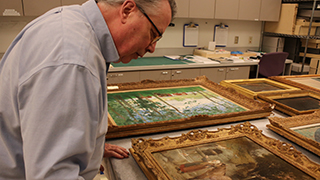From Cancer to Coatings and Cleanups - Seton Hall University
Monday, May 9, 2016
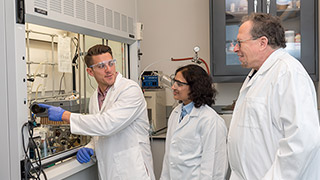
Graduate students James Sullivan and Karpagavalli Ramji work with Professor Sergiu Gorun on their patent for self-cleaning protective coatings.
Professor Sergiu M. Gorun of the Department of Chemistry and Biochemistry and graduate students Karpagavalli Ramji and James Sullivan are the co-inventors
of a patent for "Self-cleaning Protective Coatings." These protective coatings, sometimes
referred to as "smart paint," actively repel contaminants and, as a result, may protect
underlying surfaces better, longer and more completely than other paints.
Professor Gorun, who is the Director of the Center for Functional Materials at Seton Hall, in collaboration
with colleagues and students, has also applied the underlying technology in the patent
- harnessing the power of light through fluorinated photosensitizers (fluorinated
phthalocyanine) - to act as an agent of eradication in the fight against cancer, with
promising results.
Video: "Fighting Cancer with Light."
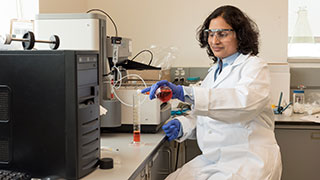
The use of this underlying research and technology to create "self-cleaning protective coatings," or "smart paint," that resulted in the patent co-authored by Ramji, Sullivan and Professor Gorun, was funded in part by the United States Air Force, which supported the research to help better safeguard its many resources from corrosion.
Corrosion is a major issue, and the world-wide market for protective coatings is big business. According to the World Paint & Coatings Industry Association, total global sales for paint and industrial coatings exceeded $128 billion in 2015. The economic impact for protective coatings, however, is far greater- as the cost of materials is normally calculated at approximately one fourth of the cost of coating, bringing the total global economic impact for paint and industrial coatings to over $500 billion in 2015 alone. And that doesn't count "down time," the period of time that a storage tank or a pipeline or some other metallic asset needs to be repainted and may not be used because rust, corrosion or contaminants have begun to threaten the integrity of the underlying surface.
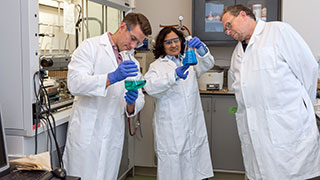
For the Air Force, corrosive pollutants are a major, and costly, issue. Bases steadily hum with the sound of diesel supply trucks and the roar of jet engines. Exhaust eats paint- and metal. With a commanding presence in hundreds of bases across the globe, and trillions of dollars in equipment, the Air Force needs paint that repels pollutants and other contaminants and extends the useful life of its materiel; thus far, the Air Force has contributed in excess of $500,000 toward Professor Gorun's research, which has also been advanced by Porter Scientific, a North Carolina contracting, consulting and service company, as well as the computational work from Professor Stephen Kelty at Seton Hall.
The Basis Research
Think of a solar panel: it captures light and produces electrons (i.e., electricity).
Now think of that solar panel as being microscopically small, and instead of producing
electrons, when activated by light in its proximity, "the fluoro panel" (fluorinated
photosensitizer) takes the oxygen from its environment and transforms it into activated
or "singlet" oxygen which, like a tiny ray gun, "shoots" and destroys carbon-based
forms in its pathway.
This technology existed in part before Professor Gorun's discovery. But, prior to his research, like a honey bee that stings once and dies, the non-fluorinated photosensitizer shot only once and, along with the target, was almost immediately consumed by the activated or "singlet" oxygen it produced. In short, each use of the non-fluorinated photosensitizers was "a suicide mission." Because of that, in any potential use, new photosensitizers would have to be continually introduced in order to provide continued effect - a costly, impractical and potentially harmful (in the case of medical use) condition.
By fluorinating the photosensitizers, however, Professor Gorun was able to create photosensitizers immune to the ravages of the activated or "singlet" oxygen. Professor Gorun's fluorinated photosensitizers shoot and shoot again and again. In fact, thus far the fluorinated photosensitizers Professor Gorun and his students have created have shown themselves to be "virtually immortal" in the lab.
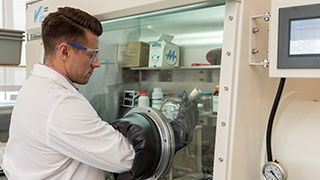
Paint
The fluorinated photosensitizers are mixed with a "breathable" polymer matrix paint
or coating. The paint itself is silicon-based and has an extremely low carbon content,
thus making it not susceptible to the ravages of the activated or "singlet" oxygen
produced by the fluorinated photosensitizers. And although the silicon-based matrix
paint repels water, it allows oxygen to enter, which, along with light, is necessary
for the fluorinated photosensitizers to work. And work they do.
When exposed to light the fluorinated photosensitizers produce these activated or "singlet" oxygen molecules that essentially "patrol" the painted surface, attacking and repelling contaminants and, in some instances, actually changing the molecular structure of the attacking substance to render it inert and incapable of chemically bonding with the paint. In this way, the surface of the painted structure is "cleaned" and the integrity of the underlying material maintained.
Cancer
Less invasive than surgery, the fluorinated photosensitizers are introduced into the
body and distribute themselves in tissues they are directed at- including cancerous
tissue. In Professor Gorun's more recent work in collaboration with Professor David
Sabatino, however, they've studied what may well be the "second generation" in this
promising technology in the fight against cancer: coupling the fluorinated photosensitizers
with "vectors" or "finder molecules," that may actually seek out and deliver the photosensitizers
to the cancer itself.
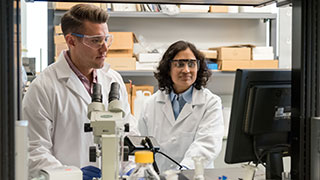
Environmental Cleanup
The same process has shown promise in remediating polluted water, with the fluorinated
photosensitizers using the oxygen at large to "deactivate" pollutants within. In addition
to the LaGrosa Award bestowed to Karpagavalli Ramji, the research has been lauded
by the United States Army as the "discovery of a water purifier," with "potential
dual use civilian application in many parts of the world where contaminants - organic
and inorganic - impact the potability of water or the availability of water."
Professor Gorun explained, "In all these applications of our research, what we are doing, simply, is taking the power of light and combining it with oxygen and the brilliance of our students to do something useful. As the director of Seton Hall's Center for Functional Materials, it is the essence of what we strive for: the practical application of research and researchers to solve real problems. This is bio-inspired catalysis, and at Seton Hall we have a long and storied history in industry and the scientific community as a focal point in the study of catalysts through our Center for Applied Catalysis. Our work is just one more important step in that journey."



